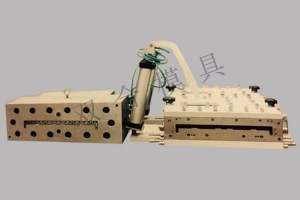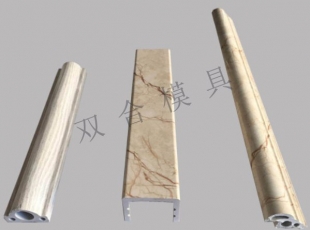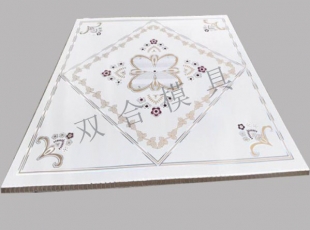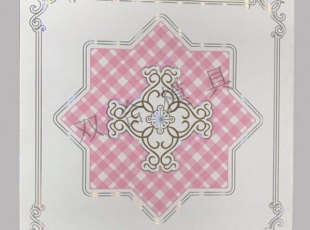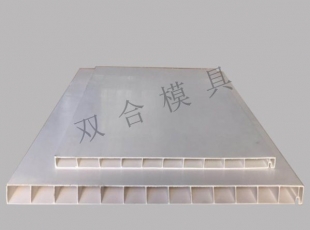Industry news
- 热门产品
- 热门新闻
- What should we pay attention to when purchasing aluminum gusset plate production equipment and aluminum gusset plate mol
- What problems will PVC plates formed by gusset mold encounter?
- In what fields are gusset dies used?
- Plug mold caused by temperature of profile mold
- What are the conditions of mold plugging caused by unreasonable design of profile mold?
- KEYWORD
Common problems and treatment methods of PVC profile mold
Common problems and treatment methods of PVC profile mold
1、Profile variant
The existence of internal stress in the profile not only causes bending deformation or cracking of the profile in use,but also affects the mechanical properties and apparent quality.
(1)Causes of internal stress in profile:
1)The profile has been extruded and stretched in the forming process,and the macromolecular orientation has high elastic deformation without relaxation,which is mainly concentrated in the surface layer,resulting in large orientation stress in these places.The uneven orientation leads to uneven internal stress.
2)During the shaping and cooling stage of the profile,when the temperature is higher than the glass transition temperature,the plastic is a viscoelastic fluid,accompanied by stress relaxation.When the temperature is lower than the glass transition temperature,the plastic becomes a solid,and it is difficult to fully adapt between the curing time and the relaxation speed of the chain segment.The formed profile will always freeze the internal stress more or less.
3)During the cooling and shaping stage of the profile,the uneven cooling shrinkage will inevitably lead to the difference of the volume temperature inside and outside the profile,up and down,left and right.
4)The profile may deform and crack after long-term storage,the change of service temperature and the change of stress condition during use.
5)The wall thickness of hollow profile is uneven,which is easy to produce uneven cooling.The cooling at the thick wall is slow,and the cooling at the thin wall is fast,resulting in internal stress due to the difference of cooling rate.Solution:the wall thickness of profile should be as equal and uniform as possible.If there must be unequal wall thickness,the connection should be gradually transitioned to avoid the mutation of section.The cooling at the thick wall must be properly strengthened in the setting mold.
(2)The size of internal stress is related to extrusion temperature,extrusion pressure,residence time of melt in the machine and other factors.Increasing the temperature can reduce the orientation stress,but we must pay attention to the defects of uneven shrinkage and increased volume temperature stress.Reducing the extrusion pressure is conducive to the reduction of orientation stress,and too fast extrusion speed will cause greater stress deformation.
2、Profile bending
(1)The bending degree of door and window profiles shall not be greater than 2mm/m.Causes of bending:in addition to excessive internal stress,there are the following:
(1)The whole production line should be adjusted on a central line.If it is not on a central line,when the profile enters the water tank through the dry setting die and is finally cooled,the profile will be artificially bent or twisted.Therefore,the concentricity and levelness of the extruder,head,setting die and tractor should be accurately corrected every time the die is replaced.
(2)Due to the asymmetry of the profile section,when the crawler of the tractor is pressed on the surface of the profile,the force on all sides of the profile will be uneven and deform,especially on the thin-walled profile.Therefore,the clamping force of the crawler of the tractor should be adjusted appropriately and the traction force should be kept constant.
(3)When storing the profile,it should be placed straight,more than 1m away from the heat source,and the stacking height should not exceed 1m to avoid plastic deformation of the profile.The storage temperature should not be too high,not more than 40℃.
(4)Uneven discharge of the die of the machine head and inconsistent speed are one of the main factors causing bending.If the flow of the machine head is not consistent,the discharge around it can be adjusted by blocking and inlaying blocks.If the temperature difference on all sides of the machine head is large,the temperature around the die should be adjusted to be consistent.
3、Bubbles.Cracks and pockmarks
(1)The main reasons for the above defects are as follows:
1)The moisture and volatile substances contained in various materials seriously exceed the standard and cannot be fully eliminated in the extrusion mixing process.The volatile substances remain in the material,and bubbles will appear inside or on the surface of the profile.After heating,bubbles,cracks and pockmarks will appear obviously in the profile.Once such defects occur in production,the influence of raw materials should be eliminated first,and then reasonable process conditions should be formulated in high-speed mixing,which can effectively eliminate volatiles.
2)PVC is a thermosensitive plastic with poor thermal stability.Although a thermosetting agent is added to the formula,if the stabilizer is not good or overheated decomposition occurs due to the disadvantages of the extrusion process,the hydrogen chloride gas produced often cannot be fully discharged and stays inside the material,and dense small pores will appear on the profile section or inner surface,The generation of such pores is related to the control ability and uniformity of the heating and cooling system of the extruder on the extrusion temperature.The extrusion temperature should not be too high,otherwise it is easy to produce superplasticization and produce too much gas residue in the profile or even cracks.The extrusion temperature is too low,the material plasticization is poor,and the unplasticized particles make the profile surface pitted,burred and rough.Adjusting the correct process temperature is the key to controlling the plasticization of materials.During the extrusion process,the heat mainly comes from the external heat source and shear friction heat.At the initial stage of startup,the heat mainly comes from external heating.After startup,the shear friction heat continues to increase,and sometimes even exceeds the heat required by the material.This requires the heat to be dissipated through the cooling system to prevent thermal decomposition.Therefore,the heating and cooling system of the extruder should ensure the stability of the extrusion temperature and high control accuracy.Shear friction heat is related to screw speed,head pressure and other factors.Adjusting screw speed and head pressure in production to make shear friction heat reasonable can improve the operating conditions of heating and cooling system to a certain extent.
3)The generation of bubbles is also related to the function of the exhaust system of the extruder.The function of the twin-screw is divided into four areas:the feeding area,the compression area,the exhaust area and the homogenization area.The pressure from the feeding area to the compression area gradually increases,and the pressure in the exhaust area drops sharply,while the pressure in the homogenization area rises rapidly.In the exhaust area,the vaporized volatiles are easy to escape from the melt due to the pressure drop,and are discharged from the exhaust port under the condition that the vacuum degree is not less than 0.05Mpa.In addition,the feeding amount and extrusion amount of the extruder should be basically balanced.When the feeding amount is greater than the extrusion amount,the excess materials will be continuously squeezed to the exhaust hole with low pressure under the action of pressure,resulting in materials emerging from the exhaust hole,and even blocking the exhaust hole,losing the exhaust function.
4)When bubbles,cracks and pockmarks occur in the profile,they can be eliminated one by one according to the situation.First,check whether the volatile components and impurities of various raw materials exceed the standard,and properly adjust the amount of lubricant and stabilizer in the formula.An appropriate amount of lubricant can be increased to reduce the shear friction heat,and a moderate amount of stabilizer can be added to ensure the temperature bearing capacity and thermal stability of the material,so as to avoid serious decomposition of the material.Secondly,according to the working characteristics of the extruder,Set a reasonable temperature,screw speed and extrusion pressure,check the vacuum degree and the working condition of the exhaust hole again to ensure smooth exhaust and good sealing,and finally check whether there is a dead corner in the mold channel.
上一页:Discoloration and whitening of PVC plastic profile mold
下一页:How to improve the surface brightness of PVC profile mold

